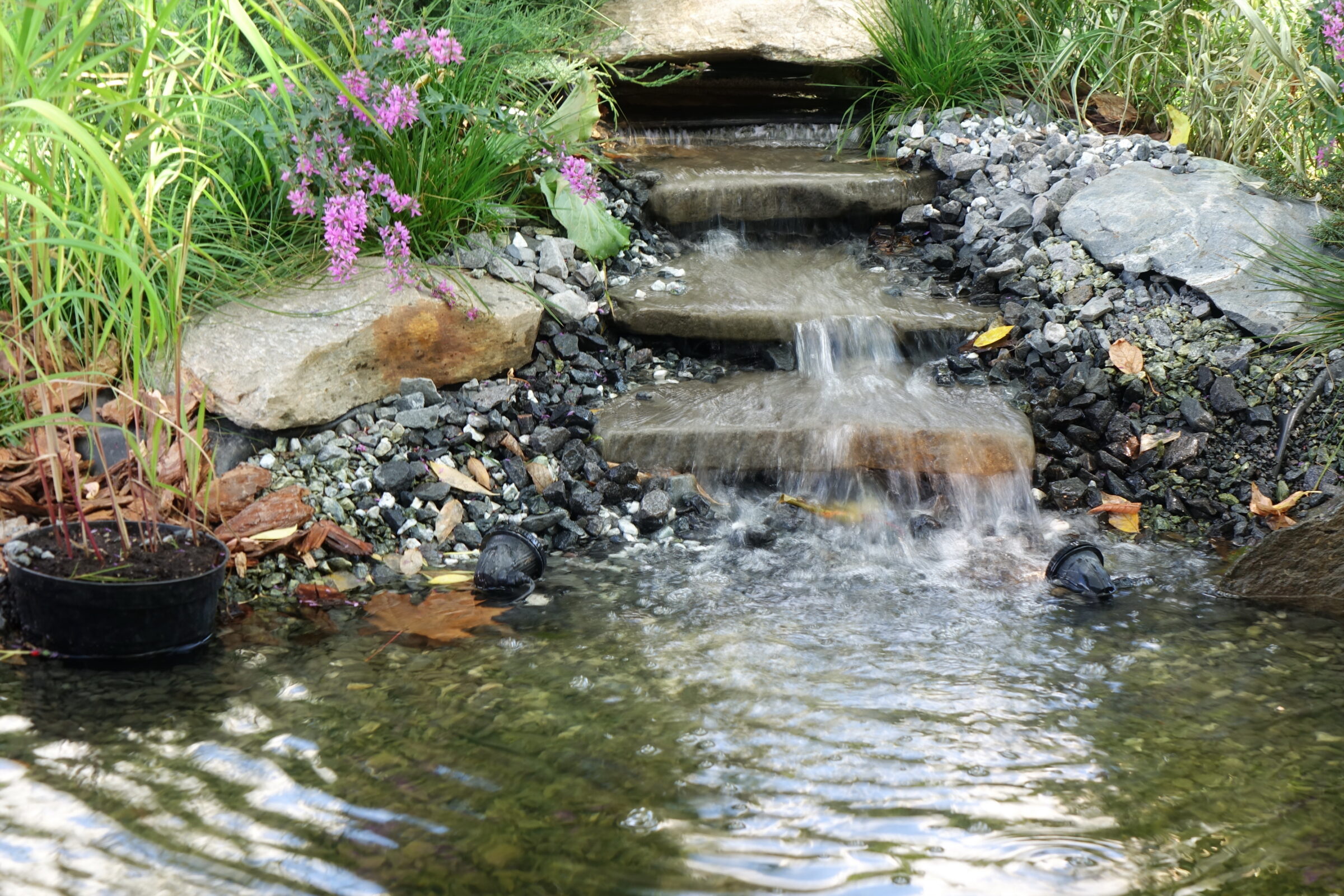Spring Gravel Projects: Backyard Ponds and Waterfalls
April 10, 2024

Adding a touch of tranquility to any outdoor space, backyard ponds and waterfalls are much loved for their soothing sounds and innate charm. These landscape features not only enhance the visual appeal but also promote an atmosphere of peace – a personal haven right at home. Setting up these garden elements does not need extensive expertise or a hefty budget. All it takes is interest, a bit of hard work, and the appropriate materials. As part of the process, gravel has a key role in creating attractive water features. Armed with a little knowledge, it’s possible to create a pond or waterfall that will transform any outdoor space.
Benefits of Gravel
Gravel isn’t just a basic ingredient for backyard pond projects. It’s a triple-threat, presenting a blend of durability, natural filtration, and visual appeal. Acting as a vital supporter, gravel sustains the structure of these projects throughout the changing seasons. But its value isn’t just on the surface. Beneath the sparkling waters, gravel functions as a natural filtration aid, helping to keep the pond crystal clear and clean. Beyond these practical roles, the natural charm of gravel boosts the visual appeal of the project, adding a splash of earthy allure that harmonizes perfectly with the surroundings.
Planning Your Project
Taking on a backyard pond and waterfall project requires obvious planning to guarantee the desired result. A key aspect of this involves meticulous design choices that factor in the proposed size, location, and how well it blends into the existing landscape.
Size should be the initial consideration, considering the available space and how the future pond and waterfall align with surrounding features. Too large, and it might overwhelm the yard; too small, and it could get lost in the landscape’s vastness.
Location comes next, considering the ease of accessibility for maintenance purposes, the slope for the waterfall, and the primary viewing location. A well-selected spot ensures that the gushing waterfall faces the main viewing point, guarantees effortless upkeep, and provides the ideal slope for water flow.
Landscape harmony is crucial for a cohesive backyard. Ensure that the design and size of the pond and waterfall fit harmoniously into the overall landscaping scheme, providing a natural and flowing visual effect.
Choosing the Right Gravel
Both practical and pleasing to the eye, a walk down the gravel aisle should include considerations about the size, shape, and color of the stones. These factors can have a quite an impact, from influencing water clarity to dictating the overall picturesque quality of your water features. Select gravel that exists naturally in the local area for a more authentic look.
Checks and Regulations
Remember, safety comes first in any construction project. Before breaking ground, make sure all utility lines are marked, and all necessary permits have been obtained. This is not only for safety but is often a legal requirement. In addition, consider a consultation with a landscape designer to help ensure a successful project.
Creating the Pond and Waterfall
Starting the project requires outlining the designated area first. Using a hose or a rope will help to achieve a natural shape for the pond. Remember to factor in enough space for your future waterfall while marking out the perimeter.
Excavation, the process of digging the pond, brings the shape to life. Depth is obviously important – varying it throughout the space creates dimension and a sense of intrigue. Once the excavation is completed, attention can be turned towards the waterfall foundation. Using a sturdy and appropriately sized stone, the ideal perch for the waterfall can be set in place.
Securing the pond liner is the next step, creating a waterproof reservoir, making sure the water stays where it’s intended. Depending on the region’s climate, a specific thickness might be required to resist puncture and to withstand the freezing and thawing cycle.
Then comes the fun part: arranging gravel and stones. Creativity plays a significant role here as these materials set a baseline of both the form and function of the pond. Well-placed stones act not only as decorations but can provide much-needed hiding spaces for aquatic life.
After the pond’s design is set, it’s time for the waterfall setup. This involves the careful installation of pumps and filters. The pumps will aid optimal circulation and aeration, while filters help maintain a healthy and clear water environment. Ensure that these are installed correctly for an effortless cascade and a thriving habitat.
A final touch to the ecosystem enhancement is the integration of plants and fish. Verdant greens and vibrant marine life breathe life into the pond, ultimately transforming it from a simple water feature into a focal point that will become the place where people want to spend time.
Maintenance Tips
Keeping the water feature clean is something that can’t be overlooked. This includes regular skimming to remove debris and prevent clogging of the system. If it’s not already included, it might also be worth considering installing a filter system to maintain proper water quality.
Plant varieties such as water lilies can also contribute to maintaining clean water by offering shade, which reduces the growth of algae. However, feeding pond life needs to be monitored closely as well. Overfeeding leads to waste which in turn promotes algal bloom. Using a tablet-style fertilizer pressed into the soil around plants will also help to avoid nutrient leaching into the water.
Seasonal changes can potentially disrupt the health of the pond or waterfall. During warmer months, increased sunlight and higher temperatures can expedite algae growth. Installing shades or ultraviolet sterilizers can help with this. During winter months, it’s critical to keep a spot in the pond open for oxygen and gas exchange. An aerator or fountain can serve this purpose.
Ongoing, regular checks for leaks and proper installation of preformed liners can prevent cracks and subsequent loss of water. If brown water is noticed, it could be a result of falling leaves and debris, especially if trees are located near the feature. Regular cleaning and careful placement away from trees can circumvent this issue. The idea is to pay attention to early signs of trouble. It’ll prevent a big headache down the road.
Considering the positioning and consistent maintenance of a backyard water feature will make it last and keep it looking incredible. Proper planning can prevent issues like interference from tree roots and chemical runoff from landscaped areas. Routine care is also key to the sustainability of the feature. In a simple way, paying attention and acting right away can keep troubles to a minimum, making sure the water feature remains a key piece to any backyard landscape.

